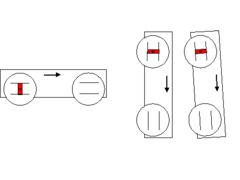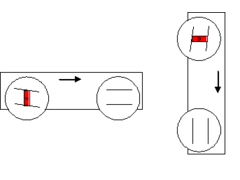jcduroc
|
| posted on 7/3/06 at 02:50 PM |

|
|
quote:
Originally posted by Syd Bridge
quote:
Originally posted by Chippy
I read somewhere that this car has anti dive, and anti squat geometry, so the strange angles at the back are almost certainly something to do with
that. I dont see much wrong with the mounting bracket, especialy when you look at the Locost bracketry.
I've said this many times, but.....
Have a good think,........ What holds the car up?........the springs. What stops it dropping down? The springs!
Now explain how angling the wishbones changes the way the springs hold the car up. All the angled wishbones do is balls up a perfectly good wishbone
setup.
Dive and squat are functions of CoM height and location, leading to weight transfer longitudinally. Changing the wishbone angles cannot affect that in
any way, shape or form. If you want less dive or squat, use harder springs, or lower the CoM. See modern racecar designs for confirmation. Wishbone
inner pivots all parallel to c/l, and ground.
I'd be looking for a geometry reason for the angles, and leave the anti dive/squat in Mr.Staniforth's book, where it belongs.
Syd.
As Syd says weight transfer has to do with CoM location (in all its 3 dims) and "g" braking force.
As he (most certainly reckons) this braking force induces moments which, if the wishbones are parallel to CL plane and groud, express only through the
springs. However, if those wishbone axis are inclined then the vector forces are split and a partial load is resisted by the springs and another is
resisted by the wishbones attachements themselves.
If it's not well explained mea culpa, English is not my first language.
Joćo
JCM
|
|
|
|
|
Mave
|
| posted on 7/3/06 at 04:30 PM |

|
|
Amen to that.
Wishbone inclination does influence the dive and squat properties. Whoever says it doesn't, claims Newton was wrong. Nothing wrong with that,
but you're just part of a small selected group that's not right. At all. 
|
|
|
TheGecko
|
| posted on 8/3/06 at 02:15 PM |

|
|
OK,
I thought about this (no, really!) and I scribbled some quick and dirty diagrams to try to illustrate the point as I see it.
For the purposes of the argument we have a simple box for the vehicle and wishbone pivot axes represented by simple horizontal lines (to start with).
The arrow on the diagram just indicates forward. We're talking here about the rear suspension and the suspension upright is shown as a red
box.
 
Susp diag 1
On the left is the vehicle at rest. It's quite obvious that, if the springs were removed (and assuming frictionless suspension pivots etc), the
vehicle would collapse until it rested on the ground. The only thing holding the chassis in that position, relative to the wheels, is the springs.
In the middle, we've hung the chassis on a wall, with the tyres glued to the wall. This removes gravity from acting in the usual direction on
the chassis. Instead, it is acting in the same way braking forces would - the chassis wants to move forward (down in the diagram) but the wishbones
etc allow no movement in that direction as the force is acting perpendicular to their axes. The chassis can still be moved left/right (equivalent to
up/down) but the 'braking force' isn't making that happen. On the right, tilting the chassis back toward horizontal would cause it to
collapse back against the wall as soon as the 'vertical' force (gravity) is able to act again.
Now lets look at a variation.
 
Susp diag 2
This is basically the same as before but the rear wishbones are inclined down towards the front - crude "anti-dive" geometry. Same
horizontal and vertical layouts as before but now it's possible to see that on the right the angle of the rear arms will cause the chassis to
rise (move right on the diagram) relative to the wheels! Where is this mysterious force coming from! Could it be.... surely not.... anti-dive?!
The forces acting on the suspension are not just those due to gravity (except when the vehicle is at rest). Under braking or acceleration there is a
horizontal component to the forces between the wheel and the chassis and that component of the forces acts through the angled arms resulting in an
upward force on the chassis relative to the wheel. I don't think anyone here is suggesting that it's enough to hold the car off the ground
(except perhaps under 10G of braking!!) but it's non-zero.
When you think about it, the same effect is why KPI assits self-centering in steering. The non-vertical pivot axis for the wheel causes it to try to
fall relative to the chassis when steered. The wheels are trying to lift the car up - not suprisingly, the car (and gravity) resist  Admittedly,
a lot of self centering comes from trail (a result of castor not KPI) but the KPI effect is real - and trail is only meaningful when moving. Admittedly,
a lot of self centering comes from trail (a result of castor not KPI) but the KPI effect is real - and trail is only meaningful when moving.
Syd, I'm getting the worrying impression from your reply that you think there are no forces other than gravity acting on a moving vehicle.
Longitudinal and lateral forces are every bit as important as vertical for a meaningful analysis.
Dominic
P.S. Everyone please excuse the rough and ready diagrams.
|
|
|
TheGecko
|
| posted on 8/3/06 at 11:34 PM |

|
|
Update:
The above message was written about midnight local time. Looking again in the cold light of morning (I wish - it was 22C overnight last night and 75%+
humidity) I think my analysis is hmmm...... imperfect  I'm going to think about this a little more and draw some better diagrams. I'm going to think about this a little more and draw some better diagrams.
Frustratingly, Syd has chosen to revise history somewhat by completely removing his message that I was replying to which then leaves my reply somewhat
out of context. Given that I got a PM suggesting that I may not have fully/properly read his message it's frustrating to find it gone  Read
into that what you will. Read
into that what you will.
Dominic
|
|
|
Syd Bridge
|
| posted on 9/3/06 at 09:03 AM |

|
|
   This was getting silly, and the site is supposed to be 'LOCOST' after all. This was getting silly, and the site is supposed to be 'LOCOST' after all.
Additionally, I had transgressed a note to myself regarding further posts involving technical design discussion. I am consciously attempting to avoid
confrontations, just for a change!  
The wisdom (or otherwise?) of age and experience tells me that we should agree to disagree, and get on with life. There are a lot more important
things to worry about. 
Syd.
I'll gladly continue any of this with anyone interested, but only politely on u2u to avoid any heated discussions.  Thank You. Thank You.
[Edited on 9/3/06 by Syd Bridge]
|
|
|
procomp
|
| posted on 9/3/06 at 09:27 AM |

|
|
You can angle the wishbones to get antisquat it has been done on many race cars over the years. However the most you can practicaly get is 20% and
dose cause other side effects.
cheers matt
|
|
|













